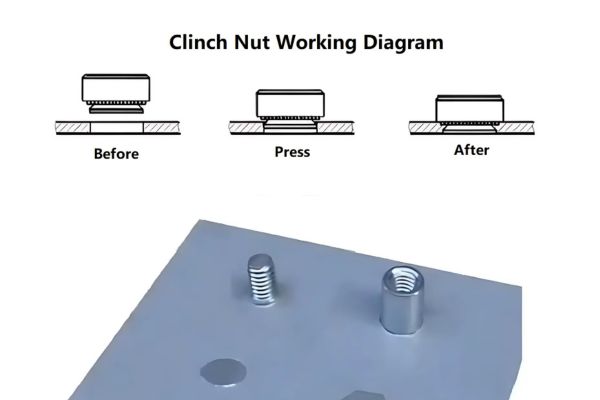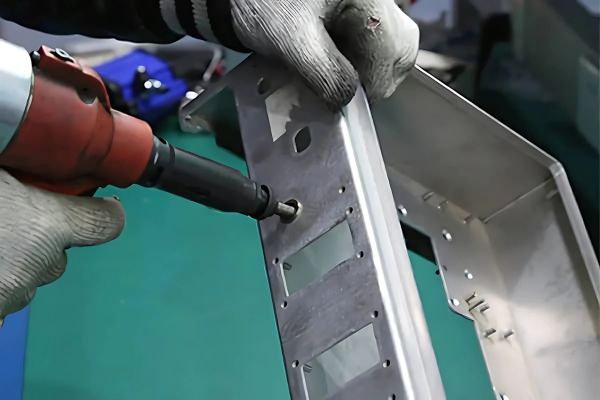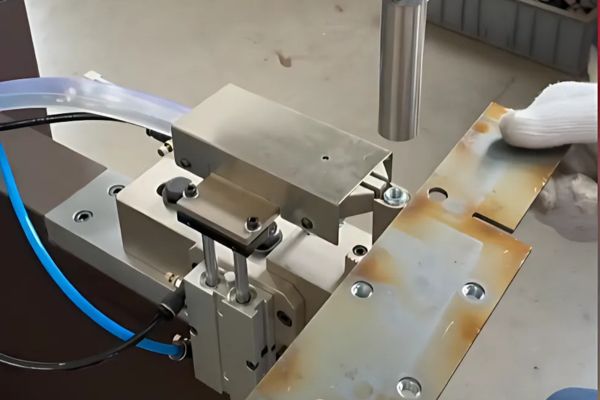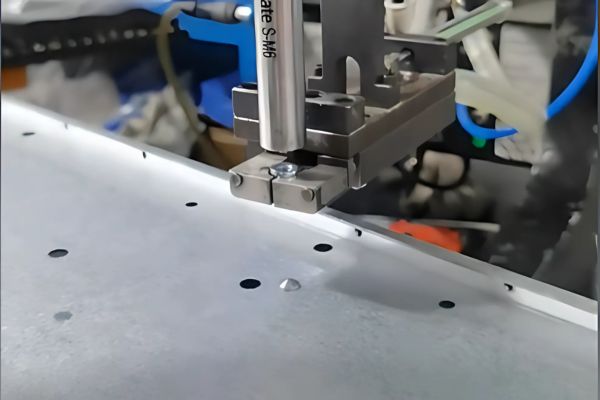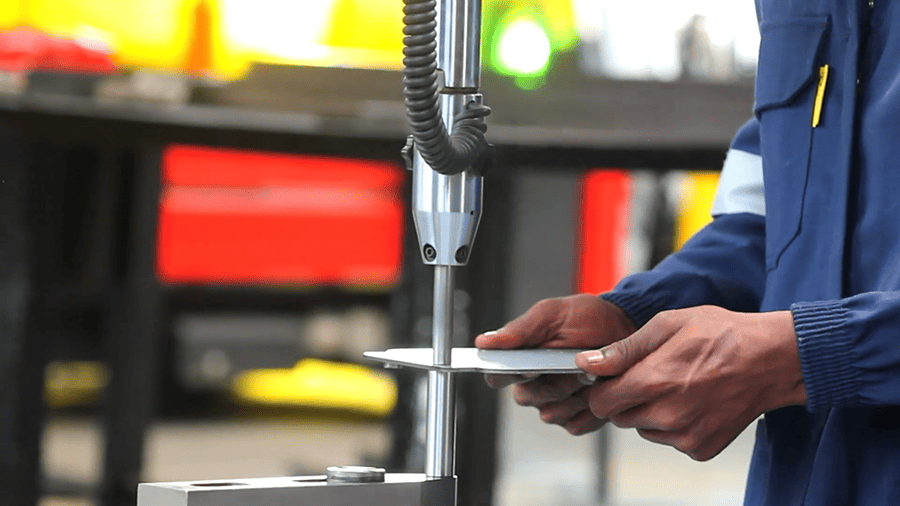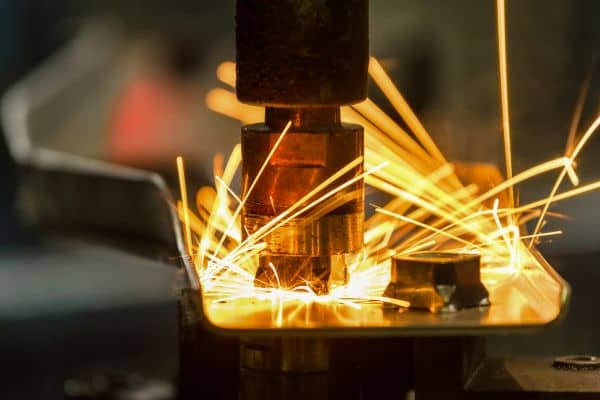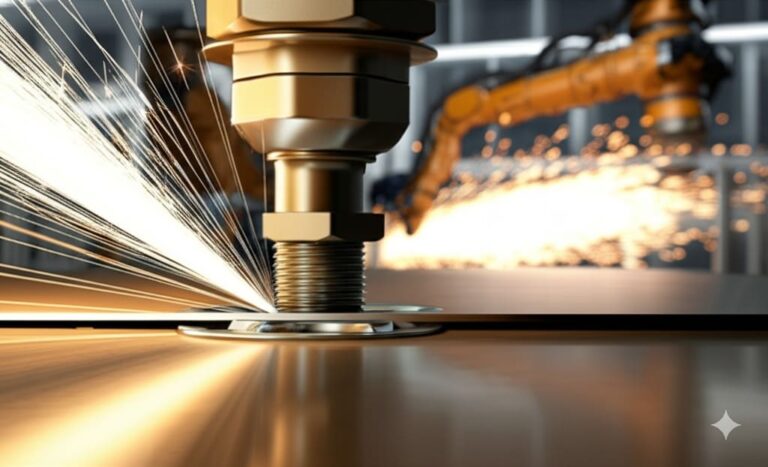How Does Clinch Nut Work?
Manufacturing engineers struggle with reliable fastening solutions for thin materials. Traditional methods like welding cause distortion and threading holes often fail under load.
A clinch nut works through controlled deformation where the nut is pressed into a pre-punched hole in sheet metal. Special teeth or knurls on the nut grip the material while pressure is applied, causing the metal to flow into retention grooves, creating a permanent mechanical bond without welding.
I first encountered clinch nuts during a factory tour in Germany back in 2015. The production manager showed me how they had reduced assembly time by 40% after switching from weld nuts. What impressed me most was the clean appearance of the finished parts – no heat marks or distortion that typically come with welding. This experience convinced me that clinch nuts represent one of the most significant advancements in sheet metal fastening technology of the past century.
What Exactly Is a Clinch Nut?
Many engineers struggle with connecting thin materials securely. Traditional fasteners require access to both sides and often create weak points in critical assemblies.
A clinch nut is a threaded fastener designed to create permanent, high-strength connections in sheet metal from one side only. It forms a mechanical interlock through controlled material displacement rather than welding, riveting, or threading, making it ideal for thin-walled applications.
When I explain clinch nuts to new customers, I often start with their origin story. These fasteners were developed to solve a specific problem in the automotive industry – how to create strong threaded connections in increasingly thin body panels without causing material distortion.
Key Components and Design Features
The seemingly simple design of a clinch nut actually contains several sophisticated engineering elements:
- Pilot Section: The tapered lead-in that helps guide the nut into the pre-punched hole
- Knurled Body: Features teeth or serrations that grip the sheet metal
- Retention Grooves: Specially designed channels where the displaced material flows to form a mechanical lock
- Threaded Center: The internal threads that provide the connection point
The genius lies in the relationship between these features. The pilot section ensures proper alignment, while the knurled body creates both friction and displacement. The retention grooves capture and lock the displaced material, and the threaded center remains unaffected by the installation process.
What many engineers don’t realize is that different clinch nut designs are optimized for specific material thicknesses and strength requirements. I’ve seen installations fail simply because the wrong variant was selected for the application.
How Does the Structure of a Clinch Nut Work?
Engineers face growing pressure to reduce assembly weight while maintaining or increasing structural integrity. Traditional fastening methods often force unacceptable compromises.
Clinch nuts work through a controlled plastic deformation process. The nut’s special features – including pilot section, serrated body, and retention grooves – work together to displace sheet metal into locking patterns. This creates a permanent mechanical bond without welding, adhesives, or secondary operations.
The working principle of clinch nuts reminds me of how nature creates strong connections. Just as tree roots interlock with soil particles to create a stable foundation, the clinch nut creates an interlocking mechanical bond with the base material.
The Science Behind the Strength
The effectiveness of a clinch nut depends on understanding the material science involved in the installation process. When I analyze failed installations, I often find that engineers underestimated the importance of these principles.
Material Flow During Installation
When pressure is applied to a clinch nut, the base material undergoes controlled plastic deformation. This process requires:
- The base material must have sufficient ductility (typically >12% elongation)
- The clinch nut must be harder than the base material (usually by 20-30 HRC)
- The pre-punched hole must be precisely sized (typically 0.1-0.3mm smaller than the nut’s pilot diameter)
These requirements ensure that the material flows predictably into the retention features without cracking or excessive thinning. I’ve conducted thousands of pull-out tests, and the correlation between proper material flow and connection strength is remarkably consistent.
Force Distribution Mechanics
The clinch nut’s ability to withstand high loads comes from how it distributes forces:
| Force Type | Distribution Mechanism | Typical Performance |
|---|---|---|
| Pull-out | Material interlock in retention grooves | 2-5kN depending on size |
| Torque | Serrated body engagement with base material | 30-120Nm depending on size |
| Shear | Load spread across entire flange contact area | Often exceeds base material strength |
This force distribution is fundamentally different from threaded fasteners, which concentrate stress at the thread root, or rivets, which rely primarily on interference fit.
What Is the Step-by-Step Installation Process?
Manufacturers struggle with inconsistent fastener installation that leads to costly failures and warranty claims. Traditional processes often depend too heavily on operator skill.
The clinch nut installation process involves: 1) Preparing a precise hole in the base material, 2) Positioning the nut over the hole, 3) Applying controlled force with specialized tooling, 4) Allowing material to flow into retention features, and 5) Releasing pressure when proper installation depth is reached.
I’ve trained hundreds of technicians on proper clinch nut installation, and I always emphasize that success depends on attention to detail. The process may seem straightforward, but each step contains nuances that affect the final connection quality.
Critical Installation Factors
The installation of clinch nuts requires careful control of several parameters. My experience has shown that overlooking any of these factors can lead to premature failure:
1. Hole Preparation
The pre-punched hole must be:
- Correctly sized (typically 0.1-0.3mm smaller than the nut pilot)
- Clean and free of burrs
- Properly positioned (maintaining minimum edge distance)
- Perpendicular to the surface (within 2° tolerance)
I once consulted on a manufacturing line where irregular hole sizing was causing a 15% failure rate. By implementing better punch maintenance and inspection procedures, we reduced failures to less than 0.5%.
2. Tool Setup and Operation
Proper tooling is critical for consistent results:
- Die geometry must match the specific clinch nut design
- Force application must be controlled and consistent
- Stroke depth should be precisely set
- Alignment must be maintained throughout the process
3. Installation Verification
After installation, various checks can confirm proper seating:
- Visual inspection of material flow into retention features
- Measurement of installed height
- Torque testing of sample installations
- Pull-out testing of production samples
In high-volume production environments, I recommend automating these verification steps through vision systems and in-line testing equipment.
What Operational Considerations Are Important?
Production managers often face quality issues when implementing new fastening technologies. Without proper guidance, even the best components can fail in real-world applications.
Key operational considerations for clinch nuts include: selecting the correct nut type for the material thickness, maintaining proper tool maintenance schedules, ensuring consistent hole quality, controlling installation force, training operators on visual inspection criteria, and implementing regular pull-out testing protocols.
During a recent factory audit, I noticed that a client’s installation issues stemmed from worn tooling rather than faulty fasteners. This experience taught me that successful implementation requires attention to the entire process, not just the components.
Preventing Common Issues
Based on my years of troubleshooting clinch nut installations, I’ve identified several critical operational areas that require attention:
Tool Selection and Maintenance
Proper tooling is essential for consistent results:
-
Tool Selection: Choose equipment appropriate for your production volume and installation requirements:
- Manual presses for low volume or prototyping
- Pneumatic/hydraulic systems for medium volume
- Automated feed systems for high volume
-
Maintenance Schedule: Implement regular checks for:
- Die wear and damage
- Alignment drift
- Force consistency
- Lubrication requirements
I recommend documenting tool condition with dated photographs to track wear patterns over time. This simple practice has helped many clients extend tool life while maintaining installation quality.
Material Considerations
Different base materials require specific approaches:
| Material Type | Special Considerations | Recommended Clinch Nut Type |
|---|---|---|
| Low Carbon Steel | Standard installation parameters | Standard round or hex body |
| High Strength Steel | Higher installation force required | Reinforced design with deeper serrations |
| Aluminum | Lower installation force, risk of cracking | Special design with modified pilot angle |
| Pre-painted/Coated | Risk of surface damage | Extended pilot design with surface protection |
Understanding these material-specific requirements has helped me guide customers to the right solution for their application, avoiding costly trial-and-error approaches.
What Are Common Questions About Clinch Nuts?
Many engineers have misconceptions about clinch nut capabilities. This leads to either overlooking them for suitable applications or attempting to use them inappropriately.
Common questions about clinch nuts include concerns about minimum material thickness, maximum load capacity, corrosion resistance, removal possibilities, automation compatibility, quality verification methods, and cost comparison with other fastening methods. The answers depend on specific application requirements.
In my technical support role, I’ve fielded thousands of questions about clinch nuts. The most valuable lessons often come from addressing misconceptions that could lead to application failures.
Frequently Asked Questions
Let me address the questions I hear most often from engineers and procurement specialists:
Can clinch nuts be removed if necessary?
Unlike welded fasteners, clinch nuts can be removed, though the process damages the base material. Removal typically involves:
- Drilling through the center of the nut
- Using a punch to drive out the remaining material
- Repairing the hole area if needed
I generally advise treating clinch nuts as permanent installations and focusing on proper quality control to minimize the need for removal.
What is the minimum material thickness for clinch nuts?
Standard clinch nuts work with material as thin as 0.5mm for aluminum and 0.8mm for steel. Micro-clinch designs can work with material down to 0.3mm in certain applications. I’ve successfully implemented clinch nut solutions in electronic housings with 0.4mm aluminum by selecting specialized variants designed for ultra-thin applications.
Are clinch nuts suitable for outdoor applications?
Clinch nuts are available in various materials and finishes for corrosion resistance:
- Zinc-plated steel for moderate environments
- Stainless steel for harsh conditions
- Specialized coatings for extreme environments
The interface between the nut and base material needs special consideration for galvanic corrosion potential. I recommend matching materials where possible or using appropriate isolation strategies.
How do I verify proper installation?
Quality verification methods include:
- Visual inspection of material flow
- Measurement of installed height
- Torque testing to specified values
- Pull-out testing to verify retention strength
In critical applications, I recommend implementing documented testing protocols with statistical process control methods.
Where Are Clinch Nuts Used in Real Applications?
Manufacturing engineers need proven solutions with track records of success. Theoretical advantages mean little without demonstrated performance in similar applications.
Clinch nuts are widely used in automotive manufacturing (body panels, seat frames, brackets), appliance production (washer/dryer frames, mounting points), electronics (server racks, enclosures), HVAC systems (air handlers, ductwork), and furniture manufacturing (metal framing). They excel where thin materials require strong threaded connections.
I’ve witnessed the evolution of clinch nut applications across multiple industries. What started as a specialized automotive solution has expanded into nearly every industry that works with sheet metal.
Case Studies from the Field
My consulting work has given me insight into how clinch nuts solve real manufacturing challenges across diverse industries:
Automotive Light-Weighting Project
A major automotive manufacturer faced pressure to reduce vehicle weight while maintaining safety standards. Their approach:
- Challenge: Reduce weight of rear seat mounting system without compromising crash performance
- Solution: Replace 2.0mm steel with 1.2mm high-strength steel using clinch nuts instead of weld nuts
- Results:
- 34% weight reduction in the component
- Elimination of post-weld finishing operations
- 12% cost reduction despite higher material cost
- No change in safety performance
The key to success was early collaboration between design and manufacturing engineers to optimize the entire assembly process around clinch nut capabilities.
Consumer Electronics Durability Improvement
A manufacturer of professional audio equipment struggled with threaded insert failures in their rack-mount equipment:
- Challenge: Threaded inserts pulled out under shipping vibration
- Solution: Redesigned mounting points using clinch nuts
- Results:
- 100% elimination of shipping failures
- Improved aesthetics without visible fasteners
- Simplified assembly process
This case demonstrated how clinch nuts can solve problems that other fastening technologies cannot, particularly in applications with vibration and thin materials.
What Are the Technical Advantages and Limitations?
Engineers need balanced information about both strengths and weaknesses of fastening technologies to make informed decisions for their specific applications.
Clinch nut advantages include single-sided installation, elimination of heat damage, high pull-out and torque resistance, vibration resistance, and clean appearance. Limitations include minimum edge distance requirements, material thickness constraints, initial tooling investment, and restrictions on very hard or brittle materials.
When advising clients on fastening solutions, I believe in presenting a complete picture. Every technology has its sweet spot, and understanding both the capabilities and limitations of clinch nuts is essential for successful implementation.
Technical Performance Analysis
My laboratory testing and field experience have revealed important performance characteristics that engineers should consider:
Mechanical Performance
Clinch nuts deliver exceptional mechanical performance in several key areas:
| Performance Metric | Typical Values | Compared to Alternatives |
|---|---|---|
| Pull-out Strength | 2-5kN (size dependent) | Equal to weld nuts, superior to rivet nuts |
| Torque Resistance | 30-120Nm (size dependent) | Equal to weld nuts, superior to rivet nuts |
| Vibration Resistance | >100,000 cycles without loosening | Superior to threaded inserts, equal to weld nuts |
| Fatigue Performance | >500,000 cycles at 60% rated load | Superior to threaded holes, equal to weld nuts |
These performance characteristics make clinch nuts ideal for applications with dynamic loading and vibration, such as automotive and machinery manufacturing.
Application Limitations
While clinch nuts offer many advantages, they do have important limitations:
-
Material Constraints:
- Requires ductile materials (>12% elongation)
- Not suitable for brittle materials like cast iron
- Challenging in very hard materials (>38 HRC)
-
Geometric Restrictions:
- Minimum edge distance of 2-3× nut diameter
- Access needed for installation tooling
- Minimum clearance required for proper material flow
-
Production Considerations:
- Initial tooling investment higher than some alternatives
- Requires precise hole preparation
- Limited field installation options
Understanding these limitations helps engineers determine whether clinch nuts are the right solution for their specific application requirements.
How Do Clinch Nuts Compare to Similar Products?
Design engineers often struggle to select the optimal fastening method among numerous options. Each technology offers different trade-offs in performance, installation, and cost.
Compared to weld nuts, clinch nuts eliminate heat damage and distortion but require more precise hole preparation. Compared to rivet nuts, clinch nuts offer superior torque resistance and faster installation but have more material limitations. Compared to self-clinching fasteners, clinch nuts work in thinner materials but require larger installation forces.
During my design reviews with clients, I often create side-by-side comparisons of fastening options. This approach helps isolate the critical factors for their specific application rather than focusing on general advantages.
Comparative Analysis of Fastening Options
When evaluating fastening solutions, I consider several key performance categories. This analysis helps identify the optimal technology for specific applications:
Installation Process Comparison
| Feature | Clinch Nut | Weld Nut | Rivet Nut | Self-Clinching |
|---|---|---|---|---|
| Access Requirement | One side | One side | One side | One side |
| Hole Preparation | Critical | Less critical | Standard | Critical |
| Installation Force | High | Low | Low | Medium |
| Installation Time | Fast (1-2 sec) | Medium (2-3 sec) | Slow (3-5 sec) | Fast (1-2 sec) |
| Equipment Cost | Medium-High | High | Low | Medium |
| Heat Required | No | Yes | No | No |
| Surface Damage | Minimal | Significant | Minimal | Minimal |
This comparison reveals why clinch nuts have largely replaced weld nuts in automated production environments – they offer similar performance with less surface damage and simpler quality control.
Performance Characteristics
| Feature | Clinch Nut | Weld Nut | Rivet Nut | Self-Clinching |
|---|---|---|---|---|
| Pull-out Strength | Excellent | Excellent | Good | Very Good |
| Torque Resistance | Excellent | Excellent | Fair | Very Good |
| Vibration Resistance | Excellent | Excellent | Good | Very Good |
| Minimum Material Thickness | 0.5mm | 0.8mm | 0.5mm | 1.0mm |
| Material Range | Good | Limited | Excellent | Limited |
| Corrosion Resistance Options | Excellent | Fair | Excellent | Good |
| Rework Possibility | Poor | Poor | Fair | Poor |
This analysis shows why clinch nuts have gained popularity in thin-sheet applications – they combine excellent mechanical performance with the ability to work in very thin materials.
I’ve found that this type of detailed comparison helps engineers make informed decisions based on their specific application requirements rather than general marketing claims.
Conclusion
Clinch nuts provide a reliable, single-sided fastening solution for thin materials through controlled deformation, offering superior strength without welding or special surface preparation, making them ideal for modern manufacturing challenges.
About Author.
I’m Losen Wei from BaiGu Rivet in China, where we specialize in manufacturing high-quality clinch nuts and other fastening solutions. With our "Easy Built!" philosophy, we’re committed to empowering your manufacturing success through reliable standard parts and customized solutions.
Our factory combines advanced machinery with technical expertise to deliver clinch nuts in all standard sizes with large stock quantities. We also support custom orders to meet your specific requirements.
If you’re looking for a reliable clinch nut supplier with consistent quality and competitive pricing, I’d love to discuss how BaiGu Rivet can support your manufacturing needs.
Contact me at [email protected] or via WhatsApp at +86 13537294786 to learn more about our products or request samples. Visit rivetclinch.com to explore our full product range.

